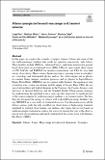| dc.contributor.author | Piro, Luigi | |
| dc.contributor.author | Ahlers, Markus | |
| dc.contributor.author | Coleiro, Alexis | |
| dc.contributor.author | Colpi, Monica | |
| dc.contributor.author | de Oña Wilhelmi, Emma | |
| dc.contributor.author | Guainazzi, Matteo | |
| dc.contributor.author | Jonker, Peter G. | |
| dc.contributor.author | Namara, Paul M. | |
| dc.contributor.author | Nichols, David A. | |
| dc.contributor.author | O’Brien, Paul | |
| dc.contributor.author | Troja, Eleonora | |
| dc.contributor.author | Vink, Jacco | |
| dc.contributor.author | Aird, James | |
| dc.contributor.author | Amati, Lorenzo | |
| dc.contributor.author | Anand, Shreya | |
| dc.contributor.author | Bozzo, Enrico | |
| dc.date.accessioned | 2022-09-06T13:47:08Z | |
| dc.date.available | 2022-09-06T13:47:08Z | |
| dc.date.issued | 2022-09-01 | |
| dc.identifier.uri | https://hdl.handle.net/1721.1/145259 | |
| dc.description.abstract | Abstract
In this paper we explore the scientific synergies between Athena and some of the key multi-messenger facilities that should be operative concurrently with Athena. These facilities include LIGO A+, Advanced Virgo+ and future detectors for ground-based observation of gravitational waves (GW), LISA for space-based observations of GW, IceCube and KM3NeT for neutrino observations, and CTA for very high energy observations. These science themes encompass pressing issues in astrophysics, cosmology and fundamental physics such as: the central engine and jet physics in compact binary mergers, accretion processes and jet physics in Super-Massive Binary Black Holes (SMBBHs) and in compact stellar binaries, the equation of state of neutron stars, cosmic accelerators and the origin of Cosmic Rays (CRs), the origin of intermediate and high-Z elements in the Universe, the Cosmic distance scale and tests of General Relativity and the Standard Model. Observational strategies for implementing the identified science topics are also discussed. A significant part of the sources targeted by multi-messenger facilities is of transient nature. We have thus also discussed the synergy of Athena with wide-field high-energy facilities, taking THESEUS as a case study for transient discovery. This discussion covers all the Athena science goals that rely on follow-up observations of high-energy transients identified by external observatories, and includes also topics that are not based on multi-messenger observations, such as the search for missing baryons or the observation of early star populations and metal enrichment at the cosmic dawn with Gamma-Ray Bursts (GRBs). | en_US |
| dc.publisher | Springer Netherlands | en_US |
| dc.relation.isversionof | https://doi.org/10.1007/s10686-022-09865-6 | en_US |
| dc.rights | Creative Commons Attribution | en_US |
| dc.rights.uri | https://creativecommons.org/licenses/by/4.0/ | en_US |
| dc.source | Springer Netherlands | en_US |
| dc.title | Athena synergies in the multi-messenger and transient universe | en_US |
| dc.type | Article | en_US |
| dc.identifier.citation | Piro, Luigi, Ahlers, Markus, Coleiro, Alexis, Colpi, Monica, de Oña Wilhelmi, Emma et al. 2022. "Athena synergies in the multi-messenger and transient universe." | |
| dc.contributor.department | MIT Kavli Institute for Astrophysics and Space Research | |
| dc.identifier.mitlicense | PUBLISHER_CC | |
| dc.eprint.version | Final published version | en_US |
| dc.type.uri | http://purl.org/eprint/type/JournalArticle | en_US |
| eprint.status | http://purl.org/eprint/status/PeerReviewed | en_US |
| dc.date.updated | 2022-09-04T03:13:33Z | |
| dc.language.rfc3066 | en | |
| dc.rights.holder | The Author(s) | |
| dspace.embargo.terms | N | |
| dspace.date.submission | 2022-09-04T03:13:33Z | |
| mit.license | PUBLISHER_CC | |
| mit.metadata.status | Authority Work and Publication Information Needed | en_US |
